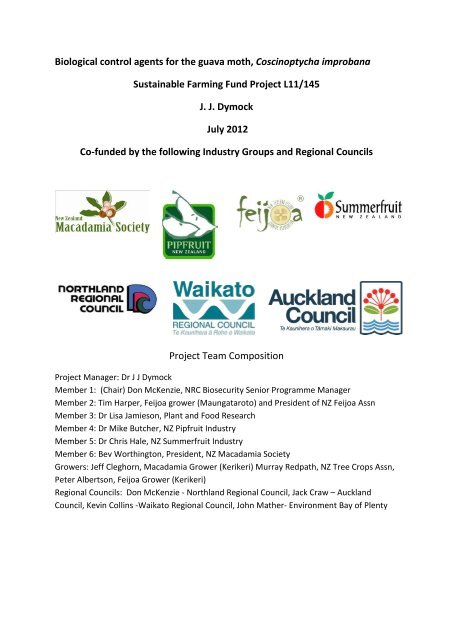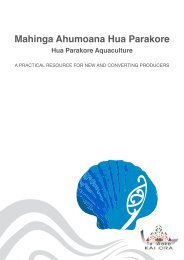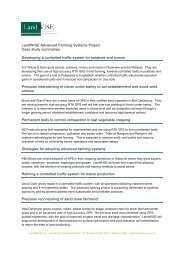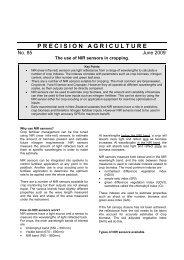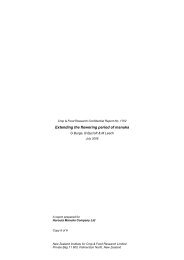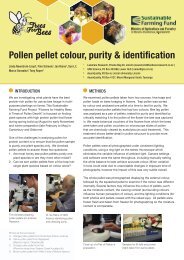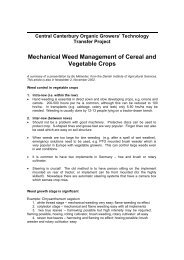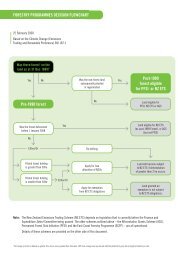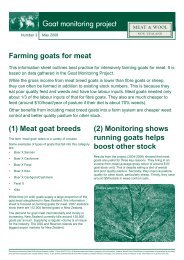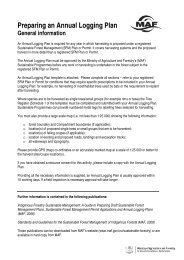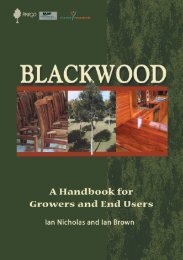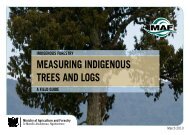Biological control agents for the guava moth, Coscinoptycha ...
Biological control agents for the guava moth, Coscinoptycha ...
Biological control agents for the guava moth, Coscinoptycha ...
Create successful ePaper yourself
Turn your PDF publications into a flip-book with our unique Google optimized e-Paper software.
<strong>Biological</strong> <strong>control</strong> <strong>agents</strong> <strong>for</strong> <strong>the</strong> <strong>guava</strong> <strong>moth</strong>, <strong>Coscinoptycha</strong> improbanaSustainable Farming Fund Project L11/145J. J. DymockJuly 2012Co-funded by <strong>the</strong> following Industry Groups and Regional CouncilsProject Team CompositionProject Manager: Dr J J DymockMember 1: (Chair) Don McKenzie, NRC Biosecurity Senior Programme ManagerMember 2: Tim Harper, Feijoa grower (Maungataroto) and President of NZ Feijoa AssnMember 3: Dr Lisa Jamieson, Plant and Food ResearchMember 4: Dr Mike Butcher, NZ Pipfruit IndustryMember 5: Dr Chris Hale, NZ Summerfruit IndustryMember 6: Bev Worthington, President, NZ Macadamia SocietyGrowers: Jeff Cleghorn, Macadamia Grower (Kerikeri) Murray Redpath, NZ Tree Crops Assn,Peter Albertson, Feijoa Grower (Kerikeri)Regional Councils: Don McKenzie - Northland Regional Council, Jack Craw – AucklandCouncil, Kevin Collins -Waikato Regional Council, John Ma<strong>the</strong>r- Environment Bay of Plenty
7 samples11 samples10 samplesMap of Sydney suburbs where samples of lilly pilly were collected.Photo: Magenta lilly pilly (Syzygium paniculatum) incubated in 2L plastic containers.
Photo: Samples of lilly pilly fruit incubated in 2L containers in <strong>the</strong> laboratory at <strong>the</strong> University ofSydneyOver <strong>the</strong> period 23–27 April 2012, <strong>the</strong> contents of each container were examined. Any insectspresent had emerged from <strong>the</strong> lilly pilly fruit since <strong>the</strong> experiment had been set up (20 and 22March). These insects were stored:• dry – Lepidoptera (<strong>moth</strong>s), Curculionidae (weevils), Tephritidae (fruit flies); or• in absolute alcohol (<strong>guava</strong> <strong>moth</strong>s only); or• in 70% alcohol – all Hymenopteran wasp specimens.Photo: Examining <strong>the</strong> contents of a 2L container of incubated lilly pilly fruit.
DNA analysis of <strong>guava</strong> <strong>moth</strong> populationsEcogene (Landcare Research) sequenced 658 base pairs of <strong>the</strong> Cytochrome oxidase I (COI) gene from<strong>the</strong> following <strong>guava</strong> <strong>moth</strong> specimens:• 10 <strong>guava</strong> <strong>moth</strong>s from four of <strong>the</strong> lilly pilly fruit samples collected in and around Sydneyon 20 and 22 March 2012• 10 larvae of <strong>guava</strong> <strong>moth</strong> infesting feijoa in Mangonui and Cable Bay (Doubtless Bay,Northland) on 17 May 2012• <strong>the</strong> leg of one pinned <strong>moth</strong> specimen from New Caledonia held at L’Institutagronomique néo-CalédonienRESULTS AND DISCUSSIONPheromone trapping of <strong>guava</strong> <strong>moth</strong>Very few <strong>guava</strong> <strong>moth</strong>s have been caught in pheromone traps baited with syn<strong>the</strong>tic <strong>guava</strong> <strong>moth</strong> sexpheromone in Australia. Only one <strong>moth</strong> was trapped in this study, in Bundaberg, QLD, in November2011. It was identified as C. improbana using morphological characters (R. Hoare, pers. comm.). No<strong>guava</strong> <strong>moth</strong>s were caught in a pheromone trap placed in a lilly pilly tree from 23–28 April 2012, inStanmore, an inner-west suburb in Sydney. Fruit from this tree had yielded <strong>guava</strong> <strong>moth</strong> duringsampling a month earlier.C. improbana has only previously been collected in <strong>guava</strong> <strong>moth</strong> sex pheromone trap in Nambour,QLD, in August 2004 (2 <strong>moth</strong>s trapped in 4 days in a derelict <strong>guava</strong> orchard, Dymock 2004,Northland Regional Council Internal Report). All pheromone traps were baited with DESIRE 2-component syn<strong>the</strong>tic <strong>guava</strong> <strong>moth</strong> sex pheromone.Insects reared from lilly pilly fruitFruit was collected from lilly pilly from 28 sites in nor<strong>the</strong>rn Sydney, Sydney north shore and innerwestsuburbs on 20 and 22 March 2012 (data available as a separate excel file).C. improbana was reared from lilly pilly fruit from 23 of <strong>the</strong> 28 sites. A total of 680 C. improbana<strong>moth</strong>s emerged from fruit samples during <strong>the</strong> study (Table 1).
Photo: Specimens of Ichneumonoidea reared from Syzygium paniculatum collected from 16McKenzie St, Lavender Bay, north of Sydney Harbour Bridge.O<strong>the</strong>r Hymenopteran wasps reared from <strong>the</strong> samples were Anselmella miltoni (Hymenoptera:Eulophidae) from 13 sites, and Megastigmus sp. (Hymenoptera: Torymidae), from ten sites. Both<strong>the</strong>se species are known as seed feeders. Megastigmus sp. is thought to be associated commensallywith A. miltoni (Juniper and Britton, 2010). These two species are too small (
It is possible that <strong>the</strong> presence of <strong>the</strong>se weevil larvae in fruit could deter <strong>guava</strong> <strong>moth</strong> fromovipositing on fruit and/or <strong>guava</strong> <strong>moth</strong> larvae successfully developing within fruit. There was norelationship between <strong>the</strong> number of Sigastus spp. weevils and <strong>the</strong> number of <strong>guava</strong> <strong>moth</strong>s emergingfrom fruit samples in this study (R 2 =0.062, t=1.25, 23 df). At least 95% of fruit from S. paniculatumcollected in Kerikeri in May 2012 and from Awanui in June 2011 were infested by an unnamedweevil larva. Attempts to rear this weevil <strong>for</strong> identification have so far proven unsuccessful.However, in New Zealand, this weevil could be excluding <strong>guava</strong> <strong>moth</strong> from <strong>the</strong> fruit as no <strong>guava</strong><strong>moth</strong> larvae have been found ei<strong>the</strong>r infesting S. paniculatum fruit or co-habiting with <strong>the</strong>se weevillarvae inside <strong>the</strong> fruit.O<strong>the</strong>r <strong>moth</strong>s (Tortricidae)Eight leafroller <strong>moth</strong>s (Lepidoptera: Tortricidae) in total were reared from seven sites. They are alsopotential non-target hosts of <strong>the</strong> Ichneumonoidea wasps found in this study.Fruit fly (Tephritidae)A total of 36 adult Tephritidae fruit flies (Bactrocera sp., probably jarvisi) were reared from fruitcollected at nine of <strong>the</strong> lilly pilly collection sites. The presence of Tephritid larvae in fruit samplesmay deter <strong>guava</strong> <strong>moth</strong> oviposition or have a detrimental effect on <strong>guava</strong> <strong>moth</strong> larval survival withinfruit, but again <strong>the</strong>re was no relationship between <strong>the</strong> number of Tephritid flies and <strong>the</strong> number of<strong>guava</strong> <strong>moth</strong>s emerging from fruit samples (R 2 = 0.097, t=1.6, 23 df). No wasp specimens of <strong>the</strong> genusDiachasmimorpha (which parasitise Tephritidae in Australia), were reared from any of <strong>the</strong> samples.DNA analysis of <strong>guava</strong> <strong>moth</strong> populationsEcogene sequenced 658 base pairs of <strong>the</strong> Cytochrome oxidase I (COI) gene from 10 larval specimensof <strong>guava</strong> <strong>moth</strong> from Doubtless Bay, New Zealand, and 10 <strong>moth</strong> specimens from Sydney, Australia.Un<strong>for</strong>tunately, <strong>the</strong>re was insufficient DNA material obtained from New Caledonian <strong>guava</strong> <strong>moth</strong>material (only a leg) to sequence DNA to determine <strong>the</strong> taxonomic status of New Caledonia <strong>guava</strong><strong>moth</strong> species.Of <strong>the</strong> ten New Zealand specimens:• nine were identical, with <strong>the</strong> same three base pairs different from <strong>the</strong> Sydney specimens• one New Zealand specimen clustered with two Sydney specimens.There<strong>for</strong>e, from <strong>the</strong> <strong>guava</strong> <strong>moth</strong> samples analysed, <strong>the</strong>re are two haplotypes present in NewZealand, with one haplotype appearing unique with respect to Sydney specimens.
Key to collection sitesNZ – 10 larvae collected from feijoa in Cable Bay and Mangonui, Doubtless Bay, 17 May 2012AUSMorgan – 2 <strong>moth</strong>s that emerged from Syzygium australe hybrid – corner of Morgan St andLivingstone Rd, Marrickville, inner-west SydneyAUSChurch –3 <strong>moth</strong>s that emerged from Syzygium paniculatum – corner of Pittwater and BakerRds, Church Point, Nor<strong>the</strong>rn Beaches 33 km NE Sydney CBDAUSBigola – 2 <strong>moth</strong>s that emerged from Syzygium paniculatum – Bigola suburb, Nor<strong>the</strong>rn Beaches,33 km NE Sydney CBDAUSGrace – 3 <strong>moth</strong>s that emerged from Syzygium paniculatum – 11 Grace Ave, Frenchs Forest,North Shore Sydney
Existing data <strong>for</strong> C. improbana analysed by Dr Andrew Mitchell, Australia Museum, Sydney, using <strong>the</strong>Barcode of Life Database (BOLD), showed very little variation in <strong>the</strong> COI gene in <strong>the</strong> 14 specimenssequenced so far, collected inland from Canberra to Orange, and Sydney to <strong>the</strong> QLD border on <strong>the</strong>coast.Nei<strong>the</strong>r lilly pilly nor acmena fruit have been recorded as hosts of <strong>guava</strong> <strong>moth</strong> in Northland (LisaJamieson pers. comm. and pers. obs.), despite being readily available to <strong>guava</strong> <strong>moth</strong>. Fruit ofmacadamia (Ruth Huwer, pers. comm.), feijoa and loquat and have not been recorded as hosts of<strong>guava</strong> <strong>moth</strong> in Australia – including fruit from four feijoa trees in Sydney examined during this study(Table 2). The most common insect infesting macadamia nuts in Queensland is <strong>the</strong> macadamia nutborer, Cryptophlebia ombrodelta (Lepidoptera: Torticidae), which may be excluding <strong>guava</strong> <strong>moth</strong>from infesting macadamia nuts.Table 2. Host fruit of <strong>guava</strong> <strong>moth</strong> common to Australia, New Zealand and Norfolk Island+ host- present, but not a host? present, but not known if a hostSpecies PlantFamilyPlace ofOriginAustralia NewZealandNorfolkIslandGuava, Myrtaceae Sth America + + +Psidium sp.Feijoa, Acca Myrtaceae Sth America - + Not presentsellowianaLilly pilly – Myrtaceae Australia + - Not presentSyzygiumpaniculatum,S. australeAcmena Mytaceae Australia + - Not presentsmithiiMacadamia Proteaceae Australia - + ?spp.Citrus spp. Rutaceae SE Asia + + ?Loquat, Rosaceae China - + ?EriobotryajaponicaPeach, Pyrus Rosaceae China - + +sp.Plum (Old Rosaceae Europe - + ?World),Prunus spp.Pear, PyruspyrifoliaRosaceae Europe - + ?
It is not known whe<strong>the</strong>r <strong>the</strong> differences in host fruit choice by <strong>guava</strong> <strong>moth</strong> in New Zealand, Australia,Norfolk Island and New Caledonia <strong>guava</strong> <strong>moth</strong>s is due to <strong>the</strong>:• presence of different biotypes of <strong>guava</strong> <strong>moth</strong> with different feeding preferences, or• presence of different insects co-habiting or competing <strong>for</strong> fruit, or• differing host fruit range available.Fur<strong>the</strong>r data are required from <strong>guava</strong> <strong>moth</strong>s across a broader geographical range (including NewCaledonia and Norfolk Island) to determine <strong>the</strong> origin of <strong>the</strong> New Zealand <strong>guava</strong> <strong>moth</strong> haplotypes.In <strong>the</strong> meantime, <strong>the</strong> differences recorded thus far are not great enough that any NZ specimens canbe recognised as representing separate species. At present, C. improbana, as a single species, is stillconsidered as <strong>the</strong> target <strong>for</strong> a bio<strong>control</strong> programme.FUTURE PLANSThe small amount of variation seen in <strong>the</strong> COI gene is typical of within-species differences.There<strong>for</strong>e, <strong>guava</strong> <strong>moth</strong>s identified by morphological characteristics in New Zealand and Australia canstill be considered a single species. The present data suggest that <strong>the</strong> geographic source of <strong>the</strong> NZ<strong>guava</strong> <strong>moth</strong> is mixed and includes areas o<strong>the</strong>r than where <strong>guava</strong> <strong>moth</strong> was collected in Sydney.More samples from different regions in Australia and NZ would be needed to confirm this.Collections of <strong>guava</strong> <strong>moth</strong> in New Caledonia and Norfolk Island are planned.Confirmation that <strong>the</strong> Ichneumonidea parasitoid wasps reared during this project are indeedparasitizing <strong>guava</strong> <strong>moth</strong> is <strong>the</strong> next step in a bio<strong>control</strong> programme <strong>for</strong> <strong>guava</strong> <strong>moth</strong>. The waspspecies identified as potential bio<strong>control</strong> <strong>agents</strong> <strong>for</strong> <strong>guava</strong> <strong>moth</strong> would be exposed to <strong>guava</strong> <strong>moth</strong>infestedfruit of lilly pilly, in <strong>the</strong> absence of o<strong>the</strong>r insect species, to determine <strong>the</strong> level of parasitism.REFERENCESBlanche, R., Bauer, R., Cunningham, S. and Floyd, R. (2002). Services and dis-services of rain<strong>for</strong>estinsects to crops in north Queensland. Cooperative Research Centre <strong>for</strong> Tropical Rain<strong>for</strong>est Ecologyand Management. Cairns. (20 pages)Common, I. F. B. (1990). Moths of Australia. Melbourne University Press, Carlton, AustraliaFay, H. A. C., De Faveri, S. G., Storey, R. I. and Watson, J. (2001) Sigastus weevil – an emergingpest of macadamias in north Queensland. Proceedings of <strong>the</strong> 6th Workshop in Tropical AgriculturalEntomology, Darwin, NT, 11–15 May 1998. NT-DPIF Technical Bulletin No. 288.Gibb, A. R., Suckling, D. M., Morris, B. D., Dawson, T. E., Bunn, B., Comeskey, D. and Dymock, J. J.(2006). (Z)-7-Tricosene and Monounsaturated Ketones as Sex Pheromone Components of <strong>the</strong>Australian Guava Moth <strong>Coscinoptycha</strong> improbana: Identification, Field Trapping, and Phenology .Journal of Chemical Ecology 32(1): 221–237.Jamieson, L. E., Dymock, J. J., Dawson, T., Froud, K. J., Seldon, D. S., Suckling, D. M., and Gibb, A. R.(2004). Guava <strong>moth</strong> in New Zealand – Distribution, hosts, lifecycle observations and discussion ofpest management options. New Zealand Plant Protection 57: 13–19.


